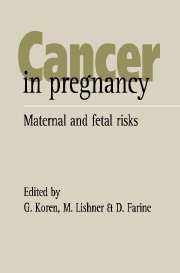Book contents
- Frontmatter
- Contents
- Preface
- List of contributors
- Part I Introduction
- Part II Specific tumors during pregnancy
- 8 Maternal and fetal outcome following breast cancer in pregnancy
- 9 Maternal and fetal outcome following Hodgkin's disease in pregnancy
- 10 Non-Hodgkin's lymphoma and pregnancy
- 11 Maternal and fetal outcome following invasive cervical cancer in pregnancy
- 12 Pregnancy and ovarian cancer
- 13 Malignant melanoma and pregnancy
- 14 Leukemia during pregnancy
- 15 Thyroid cancer and pregnancy
- Part III Fetal effects of cancer and its treatment
- Index
13 - Malignant melanoma and pregnancy
from Part II - Specific tumors during pregnancy
Published online by Cambridge University Press: 06 July 2010
- Frontmatter
- Contents
- Preface
- List of contributors
- Part I Introduction
- Part II Specific tumors during pregnancy
- 8 Maternal and fetal outcome following breast cancer in pregnancy
- 9 Maternal and fetal outcome following Hodgkin's disease in pregnancy
- 10 Non-Hodgkin's lymphoma and pregnancy
- 11 Maternal and fetal outcome following invasive cervical cancer in pregnancy
- 12 Pregnancy and ovarian cancer
- 13 Malignant melanoma and pregnancy
- 14 Leukemia during pregnancy
- 15 Thyroid cancer and pregnancy
- Part III Fetal effects of cancer and its treatment
- Index
Summary
To the students of human malignancies, malignant melanoma (MM) presents a continuous challenge. Depending on specific circumstances, this tumor may be aggressive and rapidly lethal, while in a different set-up it may be dormant for many years. It is easily resectable at its early stages and practically incurable when advanced. Above all, it is preventable by such simple measures as careful periodic examination of the skin, especially in high-risk patients and avoidance of excessive exposure to solar irradiation.
Melanoma originates from individual melanocytes, pigment cells present in the epidermis and dermis, in about two-thirds of the cases and from pre-existing cutaneous naevi in one-third. The incidence of melanoma has increased substantially over the past decades. It is estimated that approximately 29,000 new cases are diagnosed annually in the United States resulting is 6000 deaths. If this trend continues, the individual lifetime risk for this tumor will be 1%. The average age at presentation is 45 years and in some countries the incidence in women is almost double that in men. It has been noted, however, that from the time of diagnosis women have a longer survival than men.
Although men present with metastatic disease more often than women, the latter survive longer also with the same extent of disease. In stage 1 disease the most important prognostic factor is the tumor thickness at the time of resection, with five-year survival declining from 96–99% in lesions thinner than 0.76 mm to a corresponding figure of only 44–47% for lesions thicker than 4 mm.
- Type
- Chapter
- Information
- Cancer in PregnancyMaternal and Fetal Risks, pp. 134 - 142Publisher: Cambridge University PressPrint publication year: 1996
- 3
- Cited by

